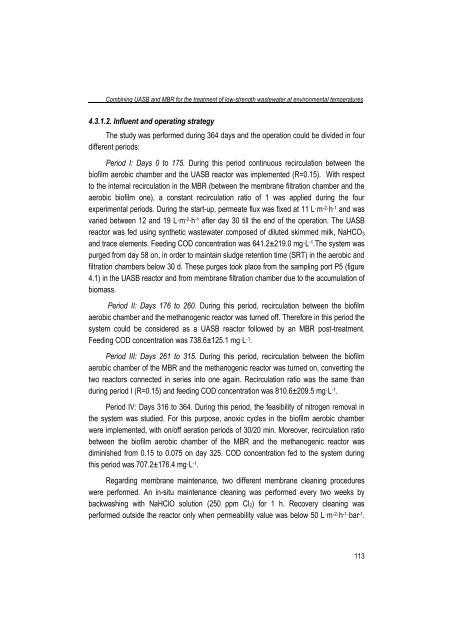Combining submerged membrane technology with anaerobic and ...
Combining submerged membrane technology with anaerobic and ...
Combining submerged membrane technology with anaerobic and ...
Create successful ePaper yourself
Turn your PDF publications into a flip-book with our unique Google optimized e-Paper software.
<strong>Combining</strong> UASB <strong>and</strong> MBR for the treatment of low-strength wastewater at environmental temperatures4.3.1.2. Influent <strong>and</strong> operating strategyThe study was performed during 364 days <strong>and</strong> the operation could be divided in fourdifferent periods:Period I: Days 0 to 175. During this period continuous recirculation between thebiofilm aerobic chamber <strong>and</strong> the UASB reactor was implemented (R=0.15). With respectto the internal recirculation in the MBR (between the <strong>membrane</strong> filtration chamber <strong>and</strong> theaerobic biofilm one), a constant recirculation ratio of 1 was applied during the fourexperimental periods. During the start-up, permeate flux was fixed at 11 L·m -2·h -1 <strong>and</strong> wasvaried between 12 <strong>and</strong> 19 L·m -2·h -1 after day 30 till the end of the operation. The UASBreactor was fed using synthetic wastewater composed of diluted skimmed milk, NaHCO 3<strong>and</strong> trace elements. Feeding COD concentration was 641.2±219.0 mg·L -1 .The system waspurged from day 58 on, in order to maintain sludge retention time (SRT) in the aerobic <strong>and</strong>filtration chambers below 30 d. These purges took place from the sampling port P5 (figure4.1) in the UASB reactor <strong>and</strong> from <strong>membrane</strong> filtration chamber due to the accumulation ofbiomass.Period II: Days 176 to 260. During this period, recirculation between the biofilmaerobic chamber <strong>and</strong> the methanogenic reactor was turned off. Therefore in this period thesystem could be considered as a UASB reactor followed by an MBR post-treatment.Feeding COD concentration was 738.6±125.1 mg·L -1 .Period III: Days 261 to 315. During this period, recirculation between the biofilmaerobic chamber of the MBR <strong>and</strong> the methanogenic reactor was turned on, converting thetwo reactors connected in series into one again. Recirculation ratio was the same th<strong>and</strong>uring period I (R=0.15) <strong>and</strong> feeding COD concentration was 810.6±209.5 mg·L -1 .Period IV: Days 316 to 364. During this period, the feasibility of nitrogen removal inthe system was studied. For this purpose, anoxic cycles in the biofilm aerobic chamberwere implemented, <strong>with</strong> on/off aeration periods of 30/20 min. Moreover, recirculation ratiobetween the biofilm aerobic chamber of the MBR <strong>and</strong> the methanogenic reactor wasdiminished from 0.15 to 0.075 on day 325. COD concentration fed to the system duringthis period was 707.2±176.4 mg·L -1 .Regarding <strong>membrane</strong> maintenance, two different <strong>membrane</strong> cleaning procedureswere performed. An in-situ maintenance cleaning was performed every two weeks bybackwashing <strong>with</strong> NaHClO solution (250 ppm Cl 2) for 1 h. Recovery cleaning wasperformed outside the reactor only when permeability value was below 50 L·m -2·h -1·bar -1 .113
















